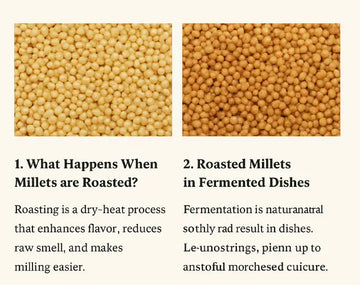Incorporating Siridhanya Millets into Your Lifestyle: A Comprehensive Guide to Healthy Grains
Sep 21, 2023
I. Introduction

Incorporating diverse grains into one's diet is crucial for optimal health and well-being. Millets, an ancient and nutrient-rich grain, offer a multitude of benefits to individuals seeking a healthy and sustainable lifestyle. This comprehensive guide will explore the importance of millets, their nutritional value, and various ways to include them in everyday meals.
II. Understanding Millets
Millets are a group of small-seeded grasses that have been cultivated for thousands of years, originating in regions of Africa and Asia. They are known for their hardiness and adaptability, thriving in various climates and soil conditions. Several types of millets are commonly consumed, including kodo millet, foxtail millet, little millet, browntop millet, Barnyard Millet (Siridhanya millets) pearl millet, finger millet, and proso millet.
These versatile grains boast an impressive nutritional profile. They are rich in vitamins and minerals, such as B vitamins, magnesium, calcium, and iron. Additionally, millets have a high fiber content, which contributes to improved digestion and satiety. Their antioxidant properties further enhance their health benefits, protecting the body from oxidative stress and inflammation.
Aside from their nutritional value, millets also offer various environmental advantages. They are drought-resistant, making them suitable for cultivation in areas with limited water resources. The sustainable farming practices associated with millet cultivation contribute to reduced water consumption and a smaller carbon footprint. Overall, millets are an eco-friendly choice for those looking to adopt a more sustainable and healthy lifestyle.
III. Health Benefits of Millets
Millets offer a range of health benefits that make them a valuable addition to any diet. They can contribute to maintaining a healthy weight, thanks to their high fiber content, which helps keep you feeling full and satisfied longer. This, in turn, can prevent overeating and assist with weight management.
Additionally, millets support digestive health by promoting regular bowel movements and preventing constipation. Their high fiber content also aids in maintaining a healthy gut microbiome, which plays a crucial role in overall health and immunity.
For individuals managing diabetes, millets can help regulate blood sugar levels due to their low glycemic index. This means that they release sugar into the bloodstream slowly, preventing spikes in blood sugar levels.
Millets are also beneficial for bone health and reducing inflammation. They contain essential minerals, such as calcium and magnesium, which contribute to strong bones and teeth. Their antioxidant properties further help in combating inflammation and promoting overall well-being.
Heart health is another area where millets shine. They are rich in heart-healthy nutrients, such as magnesium, potassium, and fiber, which can help lower blood pressure, reduce cholesterol levels, and decrease the risk of cardiovascular diseases.
Lastly, millets serve as an excellent gluten-free alternative for individuals with celiac disease or gluten sensitivity. They can easily be substituted for gluten-containing grains in various recipes, making it simpler for those with dietary restrictions to enjoy a diverse and nutritious diet.
For a prescriptive balanced diet, please check our millet protocol page -> Dr. Khader Vali Protocol
IV. Cooking with Millets: Tips and Techniques
Preparing millets for cooking can be done in various ways to enhance their flavor and texture. Soaking millets (Unpolished Siridhanya millets) in water for 6-8 hours or overnight can help soften them, making them easier to digest. Rinsing millets thoroughly before cooking removes any debris or dust, ensuring a clean and flavorful result. Toasting millets in a dry pan before cooking can bring out their nutty flavor and improve their overall taste.
There are several cooking methods to choose from when preparing millets. Boiling millets in water or broth is a simple and effective way to achieve a fluffy texture, perfect for pilafs or grain bowls. Steaming millets can result in a slightly sticky texture, suitable for dishes like sushi or onigiri. Baking millets can create a crispy exterior, ideal for incorporating into casseroles or making millet-based veggie patties.
When it comes to storage and shelf life, uncooked millets can be stored in an airtight container in a cool, dry place for up to six months. Cooked millets can be refrigerated in an airtight container for up to four days, or frozen for up to two months. Proper storage helps ensure that millets maintain their freshness and nutritional value, allowing you to enjoy their health benefits and delicious taste in a variety of dishes.
V. Delicious and Nutritious Millet Recipes
Millets can be incorporated into a wide variety of dishes, from breakfast to dessert. For a wholesome start to your day, try a comforting millet porridge, which can be prepared with your choice of milk, sweeteners, and toppings. A millet and fruit breakfast bowl offers a nutritious and colorful combination that is sure to energize your morning. Millet pancakes are another delightful breakfast option, providing a gluten-free twist on a classic favorite.
For lunch or dinner, consider a millet and vegetable stir-fry, which allows you to customize the dish with your favorite veggies and seasonings. A millet salad with roasted vegetables is a satisfying and nutrient-dense meal that can be enjoyed warm or cold. Millet stuffed peppers offer a creative and delicious way to incorporate millets into your dinner rotation, with endless possibilities for fillings and flavors.
Don't forget about snacks and desserts! Millet energy bars are a portable and nutritious option for a quick energy boost, while millet cookies are a delightful treat that can be adapted to suit your taste preferences. Millet pudding, with its creamy texture and natural sweetness, makes for a comforting and satisfying dessert to round out your millet-filled menu.
VI. Tips for Successfully Incorporating Millets into Your Diet
As you begin to incorporate millets into your diet, it's important to start slow and gradually increase your consumption. This allows your body to adjust to the increased fiber intake and prevents any potential digestive discomfort. Experimenting with different types of millets can help you discover your favorite varieties and their unique flavors and textures.
Combining millets with other grains and ingredients not only adds diversity to your meals but also enhances their nutritional value. Try mixing millets with quinoa, rice, or barley for a more interesting and satisfying dish. Sharing your newfound love for millets with family and friends can encourage them to try these versatile and nutritious grains, promoting a healthier and more sustainable lifestyle for all.
VII. Conclusion
Incorporating siridnayna millets and neutral grains/millets into your diet offers numerous health benefits, ranging from weight management to promoting heart health and supporting digestive wellness. Beyond their nutritional advantages, millets play an essential role in fostering a sustainable and healthy lifestyle, thanks to their eco-friendly cultivation practices and adaptability in various recipes. As you explore the world of millets, you are not only embarking on a journey towards improved well-being but also contributing to a brighter and more sustainable future.
At Organic Sphere, our mission is to provide valuable information and resources to help you lead a healthier, more eco-conscious lifestyle. We encourage you to dive deeper into the world of millets and discover your favorite recipes by visiting our recipe blog and exploring our collection of millet-based products.
- Africa,
- Antioxidant properties,
- Asia,
- B vitamins,
- Baking,
- Barnyard Millet,
- Blood sugar levels,
- Boiling,
- Bone health,
- Breakfast,
- Calcium,
- Comprehensive Guide,
- Conclusion,
- Constipation,
- Cookies,
- Cooking methods,
- Cooking with Millets,
- Delicious recipes,
- Desserts,
- Digestive health,
- Dinner,
- Drought-resistant,
- Energy bars,
- Environmental advantages,
- Everyday Meals,
- Family and friends,
- Fiber content,
- Finger Millet,
- Flavor,
- Foxtail Millet,
- Fruit breakfast bowl,
- Gluten-free alternative,
- Gradual increase,
- Health benefits,
- Healthy Grains,
- Healthy gut microbiome,
- Healthy weight,
- Heart health,
- High fiber content,
- Improved digestion,
- Inflammation,
- Iron,
- Lifestyle,
- Low glycemic index,
- Lunch,
- Magnesium,
- Millet-based products.,
- Millets,
- Minerals,
- Nutritional profile,
- Nutritional Value,
- Nutritious recipes,
- Organic Sphere,
- Pancakes,
- Pearl Millet,
- Porridge,
- Proso Millet,
- Pudding,
- Recipe blog,
- Regular bowel movements,
- Rinsing,
- Salad,
- Satiety,
- Shelf life,
- Snacks,
- Soaking,
- Steaming,
- Stir-fry,
- Storage,
- Stuffed peppers,
- Sustainable farming practices,
- Techniques,
- Texture,
- Tips,
- Toasting,
- Vitamins





